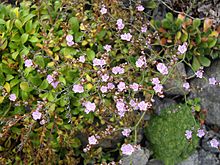
Limonium is a genus of 120 flowering plant species. Members are also known as sea-lavender, statice, caspia or marsh-rosemary. Despite their common names, species are not related to the lavenders or to rosemary. They are instead in Plumbaginaceae, the plumbago or leadwort family. The generic name is from the Latin līmōnion, used by Pliny for a wild plant and is ultimately derived from the Ancient Greek leimon.
British NVC community MC1 is one of the maritime cliff communities in the British National Vegetation Classification system. It is one of five communities categorised as maritime cliff crevice and ledge communities.

Limonium binervosum, commonly known as rock sea-lavender, is an aggregate species in the family Plumbaginaceae.

Limonium sinuatum, commonly known as wavyleaf sea lavender, statice, sea lavender, notch leaf marsh rosemary, sea pink, is a Mediterranean plant species in the family Plumbaginaceae known for its papery flowers that can be used in dried arrangements.
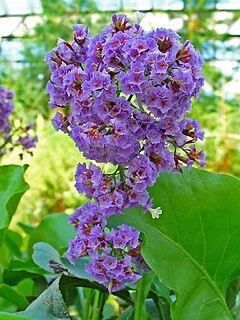
Limonium arborescens is a species of sea lavender known by the common name tree limonium and siempreviva. It is endemic to the Canary Islands, where it is a plant of coastal habitat.
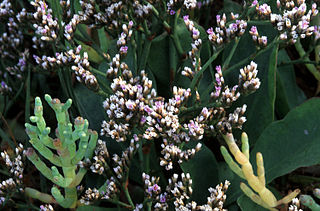
Limonium californicum is a species of sea lavender in the family Plumbaginaceae. It is known by the common names western marsh rosemary and California sea lavender.

Limonium perezii is a species of Limonium known by the common names Perez's sea lavender and seafoam statice. It is also known as simply statice, sea lavender or marsh rosemary. It is native to the coasts of the Canary Islands but are widely used in gardens throughout the world.
Limonium australe is a species of sea lavender known by the common name native sea lavender. It is native to Australia, where it is known to inhabit saltmarshes and mud flats along the eastern coast from northern Tasmania to Mackay in Queensland.
Limonium solanderi is a species of sea lavender commonly known as native sea lavender. It is native to the Australia, where it is known to inhabit salt marshes and estuaries along the eastern coast from Brisbane to Townsville in Queensland. It has small yellow flowers

The Po Basin mixed forests is an temperate broadleaf and mixed forests ecoregion in the basin of the Po River in northern Italy and Switzerland's Ticino canton.

Agdistis meridionalis, the sea-side plume, is a moth of the family Pterophoridae, first described by the German entomologist Philipp Christoph Zeller in 1847. It is found in Europe.

Agdistis bennetii is a moth of the family Pterophoridae found in Europe. It inhabits salt marshes.
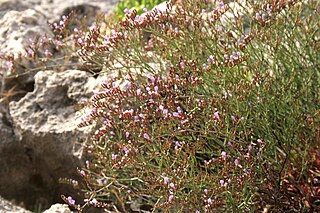
Limonium ramosissimum, the Algerian sea lavender, is a species of sea lavender (Limonium) native to the Mediterranean region. Its specific epithet rāmōsissimum means "many-branched" in Latin.

Limonium humile is a species of sea lavender known by the common name lax-flowered sea-lavender.
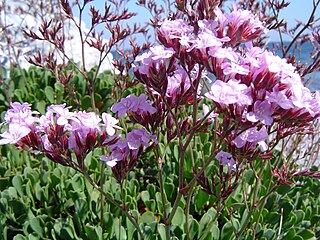
Limonium emarginatum is a species of sea lavender known by the common names Gibraltar sea lavender.

Limonium limbatum, common names trans-pecos sea-lavender or desert sea-lavender, is a plant species native to the southwestern United States and the Mexican State of Coahuila. Most of the 300 species of the genus are found on seashores and in marine salt marshes, but L. limbatum also grows on the shores of salt lakes and in alkaline depressions in desert areas, at elevations of 400–1800 m.

Limonium narbonense is a species of sea lavender belonging to the family Plumbaginaceae.

Pseudaplemonus limonii is a species of weevil from the Apioninae subfamily. It lives on Common sea-lavender on the coasts of western Europe and northwest Africa.

Limonium vulgare, called common sea-lavender, is a species of flowering plant in the genus Limonium native to the Azores, western Europe, and southwestern Sweden, and introduced elsewhere. A clumping perennial found in salt marshes and other maritime habitats, it is a probable species complex.
